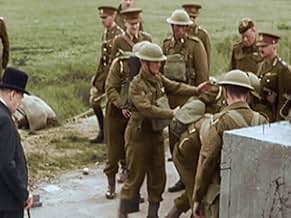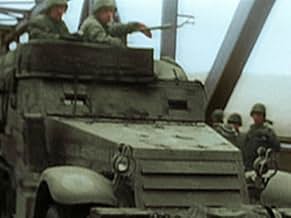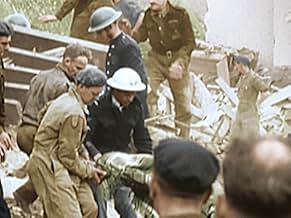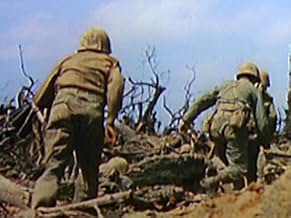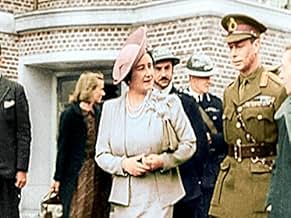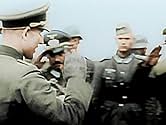Segunda Guerra Mundial em Cores
Título original: World War II in Colour
AVALIAÇÃO DA IMDb
8,7/10
7,8 mil
SUA AVALIAÇÃO
Descubra uma coleção de imagens raras da Segunda Guerra Mundial que foram coloridas digitalmente. Esse novo olhar oferece uma perspectiva diferente sobre a história do conflito.Descubra uma coleção de imagens raras da Segunda Guerra Mundial que foram coloridas digitalmente. Esse novo olhar oferece uma perspectiva diferente sobre a história do conflito.Descubra uma coleção de imagens raras da Segunda Guerra Mundial que foram coloridas digitalmente. Esse novo olhar oferece uma perspectiva diferente sobre a história do conflito.
- Artistas
Explorar episódios
Avaliações em destaque
Recently I watched this documentary series about World War II in (HD) color on Netflix and really liked it. In 14 episodes you get to see a well documented overview of WW2, starting with the events leading up to WW2 in both Europe and Sout-East Asia, the beginning stages with the fast advances both Germany and Italy made in Europe, and Japan in Asia, the mistakes made by the aggressors, the fighting back by the allied forces on different theatres, and ultimately the victories over Germany , Italy and Japan.
The interesting part about this series is that the original black & white footage has been coloured by advanced colouring techniques. While you can occasionally spot the clearly artificial colouring, most of the times it is unobtrusive and hardly noticeable. Watching these scenes in colour definitely add an aspect of realism to them, compared to the same scenes in black & white.
There are many documentaries about World War II, and this documentary deserves a good place between them.
The interesting part about this series is that the original black & white footage has been coloured by advanced colouring techniques. While you can occasionally spot the clearly artificial colouring, most of the times it is unobtrusive and hardly noticeable. Watching these scenes in colour definitely add an aspect of realism to them, compared to the same scenes in black & white.
There are many documentaries about World War II, and this documentary deserves a good place between them.
A cursory review of a series which is quite the opposite; WWII In Color is an awe-inspiring look into the second world war which provides the viewer with a comprehensive understanding of the events of WWII through narration and colorized video. This series ― narrated by Robert Powell ― covers the entirety of WWII from precursory events which would kick-start the war, to Japan's surrender and the beginning of the Cold War. In an already academically intense genre, World War II in HD Color not only meets high expectations, but exceeds them entirely. Easy to pick up, this well-researched series condenses the war into a few episode's worth of educational content. Robert Powell's delivery in narrating vital moments in the war is perfectly done as his talent shows in such a way that the viewer will surely feel the emotion behind each and every catastrophic event. Furthermore, the footage is truly moving accompanied by the expert narration which includes: devastating footage of a holocaust concentration camp, adrenaline-filled battles, convening of world leaders and more, accompanied by geographic animations, the colorized footage is sure to leave an impact. In essence, this 5 star, extremely detailed and historically accurate series will ensure you come away with nothing less than a complete understanding of many events in the Eastern and Western Fronts, the North African Campaign, and the Pacific War via colorized video and emotionally moving narration.
Documentary series on World War 2. Covers each of the major campaigns in detail and uses colourised archival footage.
An excellent documentary series. I've watched all the best WW2 documentaries, including the pinnacle of the genre, The World at War, and this is among the best.
Cynically I thought the series' selling point would be the fact that the footage is colourised and that it would rely heavily on this feature to get by. I needn't have worried: the series does not rest on the fact that it has colourised footage and other than the title of the series, no attention is drawn to this.
It's simply a great all-round documentary series: good detail without being tedious, great, relevant video material, superb, stirring, gravitas-filled narration by Robert Powell. It doesn't quite measure up to The World at War but nothing does.
An excellent documentary series. I've watched all the best WW2 documentaries, including the pinnacle of the genre, The World at War, and this is among the best.
Cynically I thought the series' selling point would be the fact that the footage is colourised and that it would rely heavily on this feature to get by. I needn't have worried: the series does not rest on the fact that it has colourised footage and other than the title of the series, no attention is drawn to this.
It's simply a great all-round documentary series: good detail without being tedious, great, relevant video material, superb, stirring, gravitas-filled narration by Robert Powell. It doesn't quite measure up to The World at War but nothing does.
This long TV series, narrated by Robert Powell, whose tone expresses earnest and dispassionate interest, deals with World War II both in the East and West. I will now present you with a detailed history of the war in its entirety, along with an extensive psychoanalytic analysis of every person involved. Not just the principals but my Uncle Flory who was a corporal in the infantry, Hockey who was an aviation ordnance man in the Navy, a German guy I met in a bar in Italy who had served in the Wehrmacht on the Russian front, and my father-in-law who was an air raid warden in Philadelphia. Well, I would if I could but I can't.
Let's summarize it this way, just for the kids: Germany, Italy, and Japan start World War II around 1939. On the other side, the chief allies are Britain, Russia, and the USA. It was a terrible conflict. We won. I'll make just a few observations.
Some of the footage is familiar from black and white documentaries, but the colorization process has advanced since the earlier, crude attempts by Ted Turner and others. The viewer hardly notices the effects after a while.
It's interesting to compare the TV documentaries about the war from the perspective of their public appearance. In early series, like "Victory at Sea" (1952), only seven years after the end of the war, the enemy is still faceless and brutal. The insults may be subtle but palpable. Listen to the narrator's pronunciation of "the Japanese", with it's built-in sneer bespeaking disgust. Later, "The World At War" (1973) regards the war itself as appalling, an emotional experience as much as anything else. Olivier's narration is mournful. By the time of this documentary (2009), the war is treated as an awesome and terrible historic event, but one that can be looked at almost as moves in a geopolitical chess game. We still see corpses, the suffering of civilians, and we hear of the atrocities, but not nearly so often as earlier, and the narrator, Robert Powell, describes the goings on as if reading from a technical manual. The barely masked loathing of "Victory at Sea" is absent, and so are Olivier's tones of tired resignation.
The historical introduction to the beginning of the war in both theaters is nicely sketched in. And the description of events is sort of smoothed over and audience friendly. None of the battles is described in much detail. Controversy is avoided. Not much in the way of personalities either, except for a handful at the very top who are concisely introduced. If the Americans landed at Salerno and were saved from defeat only by naval gunfire -- well, "the Americans landed at Salerno." Did we bomb the fifth-century Benedictine monastery atop Monte Cassino, even though it was not occupied by German troops? Yes. "Out of desperation, the Allies bombed the monastery Monte Cassino" -- period. Did George Patton and Bernard Montgomery loathe each other? This space deliberately left blank.
The lacunae mask no essential points, but some of them are interesting or amusing in themselves. And, facing facts, some of the information left out is as important as what's left in. The "battle of Britain" is hardly mentioned. In Rommel's back-and-forth battles with the British across North Africa, not nearly enough emphasis is placed on logistics, which favored the Allied forces. They could be supplied through Egypt. Rommel, however, was dependent for the importing of essential supplies on one port, Tripoli. His fuel, food, water, replacements, and matériel passed through Tripoli. The supplies were shipped from Italy, a thousand miles across the Mediterranean Sea. Then, during Rommel's advances, they had to be schlepped across another thousand or more miles on a single desert road open to air attack. On top of that, the Brits had cracked the Italian naval code and knew when the transports would leave their ports in Italy. The transports were routinely sunk by Allied air and submarines, so virtually nothing was reaching Rommel. By the end, he was draining the fuel from some of his few remaining tanks in order to keep a handful of others operational.
The deciphering of Italy's naval code was kept so secret that in one instance an air attack was launched on a transport. The airplanes were already in sight of the target when it was discovered that the ship was carrying Allied POWs. The attack was never canceled. If it had been, it would have given away the game. I find details like these interesting. Maybe the producers did too but there simply wasn't room enough for them.
Some of the material not mentioned, like the American fighting spirit at Kasserine Pass, might just as well be forgotten. Overall, and considering the weight of the subject, it's quite well done.
Let's summarize it this way, just for the kids: Germany, Italy, and Japan start World War II around 1939. On the other side, the chief allies are Britain, Russia, and the USA. It was a terrible conflict. We won. I'll make just a few observations.
Some of the footage is familiar from black and white documentaries, but the colorization process has advanced since the earlier, crude attempts by Ted Turner and others. The viewer hardly notices the effects after a while.
It's interesting to compare the TV documentaries about the war from the perspective of their public appearance. In early series, like "Victory at Sea" (1952), only seven years after the end of the war, the enemy is still faceless and brutal. The insults may be subtle but palpable. Listen to the narrator's pronunciation of "the Japanese", with it's built-in sneer bespeaking disgust. Later, "The World At War" (1973) regards the war itself as appalling, an emotional experience as much as anything else. Olivier's narration is mournful. By the time of this documentary (2009), the war is treated as an awesome and terrible historic event, but one that can be looked at almost as moves in a geopolitical chess game. We still see corpses, the suffering of civilians, and we hear of the atrocities, but not nearly so often as earlier, and the narrator, Robert Powell, describes the goings on as if reading from a technical manual. The barely masked loathing of "Victory at Sea" is absent, and so are Olivier's tones of tired resignation.
The historical introduction to the beginning of the war in both theaters is nicely sketched in. And the description of events is sort of smoothed over and audience friendly. None of the battles is described in much detail. Controversy is avoided. Not much in the way of personalities either, except for a handful at the very top who are concisely introduced. If the Americans landed at Salerno and were saved from defeat only by naval gunfire -- well, "the Americans landed at Salerno." Did we bomb the fifth-century Benedictine monastery atop Monte Cassino, even though it was not occupied by German troops? Yes. "Out of desperation, the Allies bombed the monastery Monte Cassino" -- period. Did George Patton and Bernard Montgomery loathe each other? This space deliberately left blank.
The lacunae mask no essential points, but some of them are interesting or amusing in themselves. And, facing facts, some of the information left out is as important as what's left in. The "battle of Britain" is hardly mentioned. In Rommel's back-and-forth battles with the British across North Africa, not nearly enough emphasis is placed on logistics, which favored the Allied forces. They could be supplied through Egypt. Rommel, however, was dependent for the importing of essential supplies on one port, Tripoli. His fuel, food, water, replacements, and matériel passed through Tripoli. The supplies were shipped from Italy, a thousand miles across the Mediterranean Sea. Then, during Rommel's advances, they had to be schlepped across another thousand or more miles on a single desert road open to air attack. On top of that, the Brits had cracked the Italian naval code and knew when the transports would leave their ports in Italy. The transports were routinely sunk by Allied air and submarines, so virtually nothing was reaching Rommel. By the end, he was draining the fuel from some of his few remaining tanks in order to keep a handful of others operational.
The deciphering of Italy's naval code was kept so secret that in one instance an air attack was launched on a transport. The airplanes were already in sight of the target when it was discovered that the ship was carrying Allied POWs. The attack was never canceled. If it had been, it would have given away the game. I find details like these interesting. Maybe the producers did too but there simply wasn't room enough for them.
Some of the material not mentioned, like the American fighting spirit at Kasserine Pass, might just as well be forgotten. Overall, and considering the weight of the subject, it's quite well done.
At 13 episodes of 51 minutes each, you can imagine you get a good overview of the major events of the war. For someone who is born towards the end of 20th Century, and only heard and read bits and pieces, this was a great way to connect the dots and get a total overview of those years which shaped the world even to this day. Does it feel a bit biased towards the allied forces? It does feel at times, but not too much to lose it's authenticity. I wished however to also describe how war was experienced by the civilians, what they had to go through, and especially, a dedicated episode to the atrocities against the Jewish population. It was overwhelming at times, on one hand because of the horrors shown on screen, and the other because of the continuous battle scenes, which in case of binge watching is sure to give one a headache. However, it is a must see for everyone, as it's very important to know our past, to avoid repeating the same mistakes.
Você sabia?
- CuriosidadesThough not listed among crew, the show credits Blair Wallace as colourist for the series.
- ConexõesFeatured in History Buffs: Saving Private Ryan (2016)
Principais escolhas
Faça login para avaliar e ver a lista de recomendações personalizadas
- How many seasons does World War II in Colour have?Fornecido pela Alexa
Detalhes
- Tempo de duração51 minutos
- Cor
- Proporção
- 16 : 9
Contribua para esta página
Sugerir uma alteração ou adicionar conteúdo ausente

